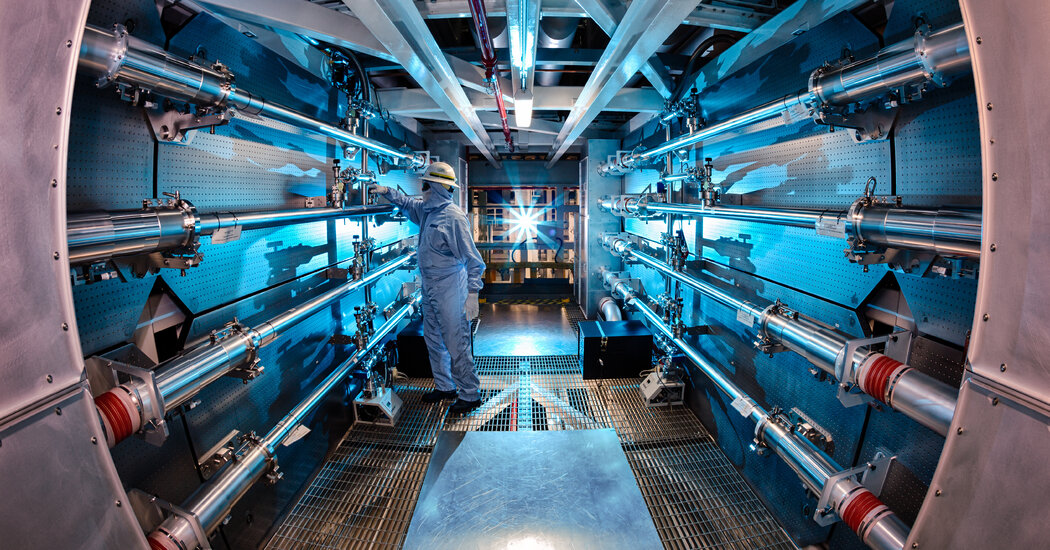Scientists at a federal nuclear weapons facility have made potentially significant progress in fusion research that could lead to a source of abundant energy in the future, according to a government official.
The advance is expected to be announced Tuesday by the Department of Energy, which said a “major scientific breakthrough” has been made at California’s Lawrence Livermore National Laboratory. Jennifer Granholm, the Secretary of Energy, and the White House and other Energy Department officials are expected to attend. The Financial Times reported on Sunday that the scientific progress concerns the National Ignition Facility, or NIF, which uses giant lasers to create conditions that momentarily mimic the explosions of nuclear weapons.
The government official, who spoke anonymously to discuss results that are not yet public, said the fusion experiment at NIF has achieved so-called ignition, where the fusion energy generated is equal to the laser energy that started the reaction. Ignition is also referred to as energy gain of one.
Such a development would improve the United States’ ability to maintain its nuclear weapons without nuclear testing and could pave the way for future advances that could one day lead to the use of laser fusion as an energy source.
While it has not yet been publicly announced, the news has spread quickly among physicists and other scientists who study fusion.
“Yesterday a scientist friend sent me a note saying that Livermore had surpassed the energy gain of one last week and would announce the result Tuesday,” said Stephen Bodner, a retired plasma physicist who has long been a critic of NIF. email Monday morning. “They deserve credit for reaching their goal.”
What is Fusion?
Fusion is the thermonuclear reaction that powers the sun and other stars: the fusing of hydrogen atoms to form helium. The mass of helium is slightly less than the original hydrogen atoms. So, through Einstein’s iconic E=mc² equation, that difference in mass is converted into a burst of energy.
Fusion that can be produced on Earth in a controlled manner could mean an energy source that does not produce greenhouse gases, such as coal and oil, or hazardous, long-lived radioactive waste, as today’s nuclear power plants do.
How do you produce fusion without a star?
Most fusion efforts to date have used doughnut-shaped reactors known as tokamaks. In the reactors, hydrogen gas is heated to temperatures high enough to remove the electrons from the hydrogen nuclei, creating a so-called plasma: clouds of positively charged nuclei and negatively charged electrons. Magnetic fields trap the plasma in the donut shape and the nuclei fuse together, releasing energy in the form of neutrons that fly out.
Tuesday’s announcement, however, takes a different approach. NIF consists of 192 gigantic lasers, firing simultaneously on a metal cylinder the size of a pencil eraser. The cylinder, heated to about 5.4 million degrees Fahrenheit, vaporizes, generating an implosion of X-rays, which in turn heats and compresses a BB-sized pellet of frozen deuterium and tritium, two heavier forms of hydrogen. The implosion fuses the hydrogen into helium, causing fusion.
What advancements in laser fusion have been made so far?
Built at a cost of $3.5 billion, the main purpose of NIF is to conduct experiments that help the United States maintain its nuclear weapons without nuclear test explosions. Proponents also said it could promote fusion research that could lead to viable commercial power plants.
However, NIF initially hardly generated any fusion. In 2014, scientists from Livermore finally reported success, but the energy produced was then miniscule — the equivalent of what a 60-watt light bulb consumes in five minutes.
Last year, scientists from Livermore reported a big jump, a burst of energy — 10 quadrillion watts of power — that was 70 percent as much as the energy of laser light hitting the hydrogen target.
But the burst – essentially a miniature hydrogen bomb – lasted only 100 trillionths of a second.
The Financial Times report on Sunday suggests that Livermore will announce that in the latest experiment, the fusion energy produced exceeds the amount of laser energy hitting the hydrogen target.
For that to happen, the fusion reaction had to be self-sustaining, meaning the deluge of particles pouring out from the hot spot in the center of the pellet heated surrounding hydrogen atoms and caused them to fuse as well.
What are the obstacles to fusion energy?
An important caveat is that the claim focuses on the laser energy hitting the hydrogen target. NIF’s lasers are extremely inefficient, meaning that only a small portion of the energy used to power the lasers actually ends up in the beams themselves.
More modern technology such as solid-state lasers would be more efficient, but still far from 100 percent fusion; for this to be practical, the fusion energy output must be at least several times that of the incoming lasers.
Does Tuesday’s announcement mean we’ll have low-cost fusion power soon?
No.
Even if scientists figured out how to generate larger bursts of fusion, huge technical hurdles would remain.
NIF’s experiments studied one eruption at a time.
A practical fusion power plant using this concept would require a machine gun pace of laser bursts with new hydrogen targets sliding into place for each burst. Then the streams of neutrons flying out from the fusion reactions should be converted into electricity.
The laser complex fills a building with a footprint equivalent to three football fields – too big, too expensive, too inefficient for a commercial power plant.
A manufacturing process would need to be developed to mass-produce the precise hydrogen targets.

